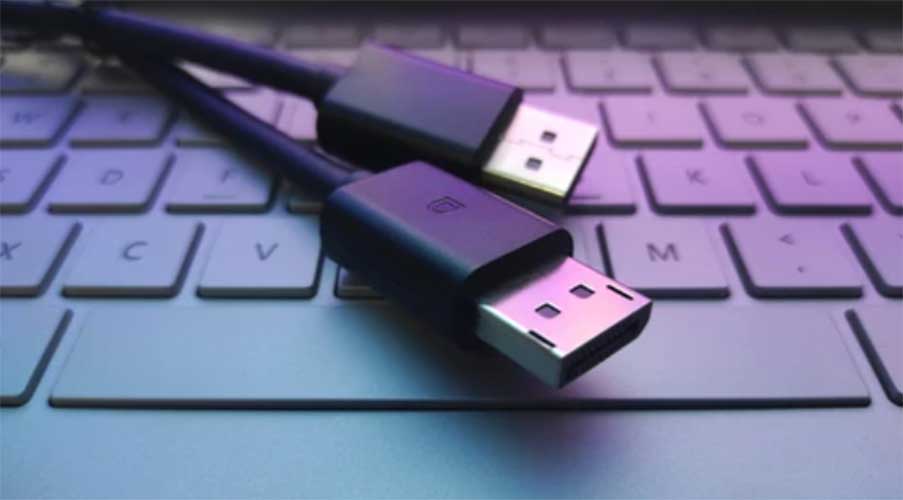Does PS5 have Displayport? (Answered)
DisplayPort is a popular connection used to output high-resolution video. It is often used in conjunction with G-Sync or FreeSync to create a smooth gaming experience. So does PS5 have a DisplayPort?
In this post, we’ll discuss why a Ps5 lacks a Displayport and the alternative option you have to connect the console to your displays.

Does PS5 have a Displayport?
The PS5 does not have a port that supports DisplayPort connections. However, there is a built-in HDMI 2.1 port on the PS5, which is currently considered a future-proof connection.
This is the first time that Sony has not supported DisplayPort in one of their consoles. HDMI 2.1 offers many advantages over DisplayPort, including 8K video at 60Hz, 4K video at 120Hz, and Dynamic HDR.
The main reason why there’s no Displayport on a Ps5 is that many TVs and displays don’t come with a Displayport.
If Sony were to include a Displayport on the PS5, it would be an extra cost for consumers, and many people wouldn’t even use it.
The other reason is that Sony is focusing on developing new technologies, like 8K resolution and 120hz refresh rates. Currently, these specs are provided by the revolutionary HDMI 2.1.
Difference between HDMI Port and Displayport
A Displayport is a type of video connector that was designed to replace VGA, DVI, and HDMI. It can carry both video and audio signals, making it a versatile option for connecting displays and audio devices. HDMI is one of the most commonly used connection standards for consoles and displays.
HDMI (High-Definition Multimedia Interface) is a proprietary audio/video interface for transmitting uncompressed digital video and audio.
HDMI and Displayport ports may look similar, but they have some key differences. Here are the top differences between HDMI and Displayport:
Grade standard
The first difference is that HDMI is a consumer-grade standard, while Displayport is a professional-grade standard.
This means that HDMI is typically found in lower-end devices, while Displayport can be found in more expensive and high-end devices.
Bandwidth
DisplayPort 1.2 cables can achieve a bandwidth of 17.28 Gbps. DisplayPort 1.4 cables can support a bandwidth of up to 25.92 Gbps.
HDMI 2.0, the most commonly used HDMI version supports bandwidth up to 14.4 Gbps. The latest HDMI 2.1 support bandwidth up to 48 Gbps. This is, no doubt, the next-level connection standard for consoles and displays.
Resolution
DisplayPort 1.2 supports a resolution of up to 3840 x 2160 pixels, while DisplayPort 1.2 supports a resolution of up to 5120 x 2800 pixels.
The HDMI 2.0 supports 4K at 60Hz. HDMI 2.1 supports 8K at 60 Hz and 4K at 120 Hz. The maximum resolution for HDMI 2.1 is 10K.
Audio return channel
HDMI supports an Audio Return Channel, meaning that it’s possible to send sound from a display to its source. HDMI cables are the most common type of cable used to connect devices like televisions and gaming consoles.
DisplayPort doesn’t support Audio Return Channel, meaning it’s not possible to send sound from the display back to the source.
Number of connections
HDMI is a point-to-point connection, while Displayport is a multi-point connection. This means that HDMI can only transmit video and audio from one device to another, while Displayport can transmit video, audio, and data to multiple devices.
Connector types
DisplayPort connectors have 20 pins and are available in two sizes: the standard DisplayPort and the mini DisplayPort by Apple.
Type A, Type C, and Type D HDMI connectors have 19 pins. Type B HDMI, which is not so common, has 29 pins.
Can I Use HDMI to Displayport for PS5?
HDMI and Displayport are both video output standards, but they are not compatible with each other. If you want to use HDMI to display video games on a PS5, you need an adapter that converts HDMI to Displayport.
HDMI to Displayport adapters are readily available and work with most devices. Simply connect the HDMI end of the converter to the console and the Displayport end to the monitor. The only thing you may need to do is change the settings on your monitor to reflect the new input.
How Do I Connect My Monitor To PS5 Displayport?
As mentioned above, to connect your Ps5 to a monitor with a DisplayPort, you need an HDMI to DisplayPort Adapter. Once you have this device follow these steps to make the connection:
- Connect the USB cable of the adapter to the Ps5 to power up the little device.
- Connect the HDMI male end of the adapter to your Ps5.
- Connect the Displayport female end to one end of the Displayport cable.
- Connect the other end of the DisplayPort cable to the monitor.
- Go to your Ps5 menu and choose Screen and Video.
- Scroll to the bottom and enable 120 Hz output.
- Navigate to the Saved Data Settings.
- Navigate to the Game Presets section.
- Under Performance Mode, choose Performance Mode.
- Your PS5 is now connected and set to display on your Displayport-enabled monitor.
Does Displayport Carry Audio?
DisplayPort is a digital display interface that was designed by a consortium of PC and chip companies and standardized by the Video Electronics Standards Association (VESA). It allows for the transmission of both digital video and audio signals from a source device to a display.
Displayport supports up to 8 digital audio channels at up to 24-bit and 192 kHz audio signal transmission. This allows for a much higher quality audio experience when using DisplayPort-enabled displays.
The Bottom Line:
To conclude this post, it’s important to remember that PS5 may or may not have Displayport. Well, this information isn’t the only thing that matters.
What do you do if you already have a Displayport-enabled monitor and don’t want to buy a new one just for the new console? It’s simple; you can just use an HDMI to DisplayPort adapter and then follow the steps discussed in this post to make your connection.